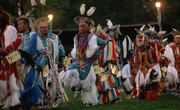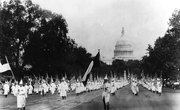Irish immigration to the United States has left a lasting impression on American culture. Although the Irish had been immigrating to America since colonial times, the largest waves of immigrants came in the 1850s -- during the Irish Potato Famine. Once they settled in the United States, the Irish imported and adapted their cuisine, genres of music, religious traditions and a new style of political organizing, among many other traditions.
The Food
The Irish brought a rich culinary tradition that they adapted to the foods available in America. A case in point is the Irish-American dish of corned beef and cabbage. In Ireland, the Irish frequently ate boiled pork products -- ham, salt pork or bacon -- with cabbage and potatoes. Once they arrived in America, however, they found pork was more expensive than beef, so they replaced pork with corned beef. The dish was often eaten in establishments that are now essential to America's restaurant landscape -- the Irish pub. The Irish public house is an Irish institution, a gathering place to eat, drink and enjoy Irish culture.
Union Organizing
When the Irish arrived in America, especially in the 1850s, they faced harsh discrimination from nativist groups like the Know Nothings. Anti-Catholic sentiments in America forced the Irish to fall back on traditions of ethnic organization that they had known in Ireland. In the 19th century, Irish-Americans stuck together in their places of employment and built the infrastructure for America's labor unions. This included unions in the public sector, such as those associated with police forces, railroad workers and utility contractors.
St. Patrick's Day
St. Patrick's Day is a day when Americans celebrate Irish culture. Irish immigrants actually made the holiday more popular in America than it was in Ireland. Up until the mid-20th century, St. Patrick's Day was a minor religious holiday in Ireland, where families attended Catholic mass and had a large meal. In keeping with Irish immigrants' desire to maintain ethnic solidarity, they turned St. Patrick's Day into an annual celebration of Irish heritage. The roots of this idea were found as early as 1762, when Irish soldiers in the British Army marched through New York City to reconnect with their heritage on March 17.
The Fighting Irish
The Irish in America earned a reputation for hot tempers and fervent pugilism that culminated in the introduction of a new sport -- boxing. Rooted in a sense of Irish solidarity against anti-Catholic opponents, boxing often intertwined with politics. The power brokers of New York City's Tammany Hall, hired thugs who used their fists to assert the political machine's power. Boxers such as John Sullivan and John Morrissey fostered the reputation of the "Fighting Irish."
Musical Heritage
Irish-American immigrants brought new styles of music and types of lyrics to America's music scene. Irish ballads, such as "Danny Boy," "My Wild Irish Rose," and "When Irish Eyes Are Smiling," became popular among the Irish and non-Irish alike. Stephen Foster, an American composer, incorporated Irish lyricism and pentatonic scale into his works.
Related Articles
References
Writer Bio
Kevin Wandrei has written extensively on higher education. His work has been published with Kaplan, Textbooks.com, and Shmoop, Inc., among others. He is currently pursuing a Master of Public Administration at Cornell University.











